Millman's Theorem
In Millman's Theorem, the circuit is
re-drawn as a parallel network of branches, each branch
containing a resistor or series battery/resistor
combination. Millman's Theorem is applicable only to those
circuits which can be re-drawn accordingly. Here again is
our example circuit used for the last two analysis methods:

And here is that same circuit, re-drawn for
the sake of applying Millman's Theorem:
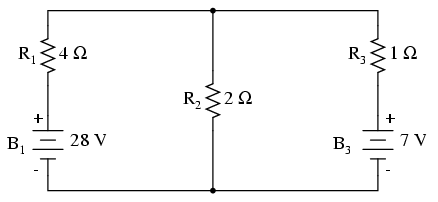
By considering the supply voltage within
each branch and the resistance within each branch, Millman's
Theorem will tell us the voltage across all branches. Please
note that I've labeled the battery in the rightmost branch
as "B3" to clearly denote it as being in the
third branch, even though there is no "B2" in the
circuit!
Millman's Theorem is nothing more than a
long equation, applied to any circuit drawn as a set of
parallel-connected branches, each branch with its own
voltage source and series resistance:
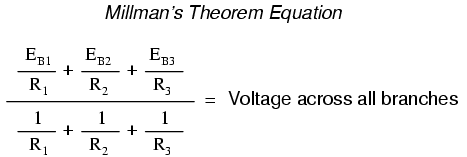
Substituting actual voltage and resistance
figures from our example circuit for the variable terms of
this equation, we get the following expression:
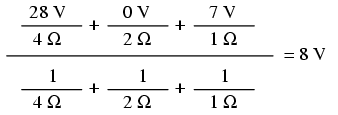
The final answer of 8 volts is the voltage
seen across all parallel branches, like this:
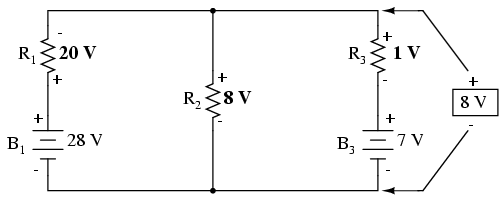
The polarity of all voltages in Millman's
Theorem are referenced to the same point. In the example
circuit above, I used the bottom wire of the parallel
circuit as my reference point, and so the voltages within
each branch (28 for the R1 branch, 0 for the R2
branch, and 7 for the R3 branch) were inserted
into the equation as positive numbers. Likewise, when the
answer came out to 8 volts (positive), this meant that the
top wire of the circuit was positive with respect to the
bottom wire (the original point of reference). If both
batteries had been connected backwards (negative ends up and
positive ends down), the voltage for branch 1 would have
been entered into the equation as a -28 volts, the voltage
for branch 3 as -7 volts, and the resulting answer of -8
volts would have told us that the top wire was negative with
respect to the bottom wire (our initial point of reference).
To solve for resistor voltage drops, the
Millman voltage (across the parallel network) must be
compared against the voltage source within each branch,
using the principle of voltages adding in series to
determine the magnitude and polarity of voltage across each
resistor:

To solve for branch currents, each resistor
voltage drop can be divided by its respective resistance
(I=E/R):
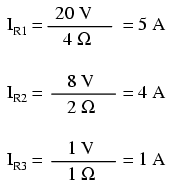
The direction of current through each
resistor is determined by the polarity across each resistor,
not by the polarity across each battery, as current
can be forced backwards through a battery, as is the case
with B3 in the example circuit. This is important
to keep in mind, since Millman's Theorem doesn't provide as
direct an indication of "wrong" current direction as does
the Branch Current or Mesh Current methods. You must pay
close attention to the polarities of resistor voltage drops
as given by Kirchhoff's Voltage Law, determining direction
of currents from that.
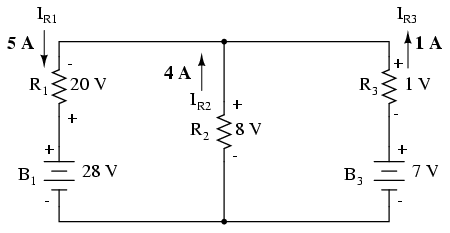
Millman's Theorem is very convenient for
determining the voltage across a set of parallel branches,
where there are enough voltage sources present to preclude
solution via regular series-parallel reduction method. It
also is easy in the sense that it doesn't require the use of
simultaneous equations. However, it is limited in that it
only applied to circuits which can be re-drawn to fit this
form. It cannot be used, for example, to solve an unbalanced
bridge circuit. And, even in cases where Millman's Theorem
can be applied, the solution of individual resistor voltage
drops can be a bit daunting to some, the Millman's Theorem
equation only providing a single figure for branch voltage.
As you will see, each network analysis
method has its own advantages and disadvantages. Each method
is a tool, and there is no tool that is perfect for all
jobs. The skilled technician, however, carries these methods
in his or her mind like a mechanic carries a set of tools in
his or her tool box. The more tools you have equipped
yourself with, the better prepared you will be for any
eventuality.
-
REVIEW:
-
Millman's Theorem treats circuits as a
parallel set of series-component branches.
-
All voltages entered and solved for in
Millman's Theorem are polarity-referenced at the same
point in the circuit (typically the bottom wire of the
parallel network).
|